GPS Velocity and Strain Rate Fields in Southwest Anatolia from Repeated GPS Measurements
Abstract
:1. Introduction
2. Burdur-Fethiye fault zone
3. GPS Observation and Data Processing
4. Strain Analysis
5. Results and Discussion
6. Conclusions
References and Notes
- Hager, B.H.; King, R.W.; Murray, M.H. Measurements of crustal deformation using the Global Positioning System. Annu. Rev. Earth Planet 1991, 19, 351–382. [Google Scholar]
- Reilinger, R.; McClusky, S.; Vernant, P.; Lawrence, S.; Ergintav, S.; Çakmak, R.; Özener, H.; Kadirov, F.; Guliev, I.; Stepanyan, R.; Nadariya, M.; Hahubia, G.; Mahmoud, S.; Sakr, K.; ArRajehi, A.; Paradissis, D.; Al-Aydrus, A.; Prilepin, M.; Guseva, T.; Evren, E.; Dmitrotsa, A.; Filikov, S.V.; Gomez, F.; Al-Ghazzi, R.; Karam, G. GPS constraints on continental deformation in the Africa-Arabia-Eurasia continental collision zone and implications for the dynamics of plate interactions. J. Geophys. Res 2006, 111, B05411. [Google Scholar]
- Sella, G.F.; Dixon, T.H.; Mao, A. REVEL: A model for recent plate velocities from space geodesy. J. Geophys. Res 2002, 107, 4873–4879. [Google Scholar]
- McClusky, S.; Reilinger, R.; Mahmoud, S.; Ben Sari, D.; Tealeb, A. GPS constraints on Africa (Nubia) and Arabia plate motions. Geophys. J. Int 2003, 155, 126–138. [Google Scholar]
- Le Pichon, X.; Chamot-Rooke, N.; Lallemant, S.; Noomen, R.; Veis, G. Geodetic determination of the kinematics of central Greece with respect to Europe: Implications for eastern Mediterranean tectonics. J. Geophys. Res 1995, 100, 12,675–12,690. [Google Scholar]
- Reilinger, R.; McClusky, S.; Oral, M.; King, R.; Toskoz, M.; Barka, A.; Kinik, I.; Lenk, O.; Sanli, I. GPS measurements of present-day crustal movements in the Arabia-Africa-Eurasia plate collision zone. J. Geophys. Res 1997, 102, 9983–9999. [Google Scholar]
- McClusky, S.; Balassanian, S.; Barka, A.; Demir, C.; Ergintav, S.; Georgiev, I.; Gurkan, O.; Hamburger, M.; Hurst, K.; Kahle, H.; Kastens, K.; Kekelidze, G.; King, R.; Kotzev, V.; Lenk, O.; Mahmoud, S.; Mishin, A.; Nadriya, M.; Ouzounis, A.; Paradissis, D.; Peter, Y.; Prilepin, M.; Reilinger, R.; Sanli, I.; Seeger, H.; Tealeb, A.; Toksoz, M.N.; Veis, G. Global Positioning System constraints on plate kinematics and dynamics in the eastern Mediterranean and Caucasus. J. Geophys. Res 2000, 105, 5695–5719. [Google Scholar]
- Reilinger, R.; Ergintav, S.; Bürgmann, R.; McClusky, S.; Lenk, O.; Barka, A.; Gurkan, O.; Hearn, L.; Feigl, K.L.; Cakmak, R.; Aktug, B.; Ozener, H.; Töksoz, M.N. Coseismic and postseismic fault slip for the 17 August 1999, M = 7.5, Izmit Turkey Earthquake. Science 2000, 289, 1519–1524. [Google Scholar]
- Yağmurlu, F.; Bozcu, M.; Şentürk, M. Investigation of seismotectonic characteristics of Burdur faults in between Burdur and Fethiye region. Technical report TÜBITAK, 101Y027, Environment, Atmosphere, Earth and Marine Sciences Research Grant Group, 2005 (in Turkish).
- Barka, A.; Reilinger, R.; Şaroğlu, F.; Şengör, A.M.C. The Isparta Angle: Its importance in the neotectonics of the eastern Mediterranean region. IESCA Proceedings, San Luis Potosi, Mexico, 1995; pp. 13–18.
- Karaman, M.E. Burdur ve dolaylarının genel stratigrafisi. Isparta Mühendislik Fakültesi Dergisi 1986, 2, 23–26. (in Turkish).. [Google Scholar]
- Koçyiğit, A. Hoyran gölü (Isparta büklümü) Dolayının Tektoniği. Türkiye Jeol. Kur. Bülteni 1983, 26, 1–10. (in Turkish).. [Google Scholar]
- Taymaz, T.; Price, S. The 1971 Burdur earthquake sequence, SW Turkey: a synthesis of seismological and geological observations. Geophys. J. Int 1992, 108, 589–603. [Google Scholar]
- Yağmurlu, F.; Savaşçın, Y.; Ergün, M. Relation of alkaline volcanism and active tectonism within the evolution of the Isparta Angle, SW Turkey. J. Geol 1997, 105, 717–728. [Google Scholar]
- Şahin, S. Distribution of stress in southwest Anatolia and its influence on the Burdur fault. J. Earth Sci. Appl. Res. Istanbul Univ. 2004, 17, 1–9. (in Turkish).. [Google Scholar]
- Yağmurlu, F. Burdur fayının sismotektonik özellikleri. Batı Anadolu’nun Depremselliği Sempozyumu 2000, 143–151. (in Turkish).. [Google Scholar]
- Oral, B.C. GPS measurement in Turkey 1988–1992 kinematics of the Africa-Arabia Eurasia plata collision zone. Massachusetts Institute of Technology: Cambdrige, Massachusetts, USA, 1994. [Google Scholar]
- Verhaert, G.; Tohon, S.D.; Vangycke, S.; Sintubin, M.; Muchez, P. Different stress states in the Burdur-Isparta region (SW Turkey) since Late Miocene times: a reflection of a transient stress regime. J. Struc. Geol 2006, 28, 1067–1083. [Google Scholar]
- Pinar, A.; Yilmazer, M.; Canbay, E.; Altuncu, S.; kalafat, D.; Kuge, K. Present day evidences of extensional tectonics in SW Turkey resulting from the subduction along the Hellenic and Cyprus arcs. Proceedings of Japan Geoscience Union Meeting, Chiba City, Japan, 16–21 May 2009. (in press)..
- Tarı, E.; Baykal, O.; Şahin, M. GPS data processing for geodynamics at ITU with GAMIT/GLOBK software. 1999; 335–347. [Google Scholar]
- Altamimi, Z. ITRF Status and Plans for ITRF. IVS 2000 General Proceedings; 2000. [Google Scholar]
- J.; Grafarend, E.W. The statistical analysis of geodetic deformation (velocity and strain rate) derived from the space geodetic measurements of BIFROST project in Fennoscandia. Geodynamics 2007, 43, 214–238. [Google Scholar]
- Pesci, A.; Teza, G. Strain rate analysis over the central Apennines from GPS velocities: the development of new free software. Boll. Geodesia Sc. Aff 2007, 56, 69–88. [Google Scholar]
- Shen, Z.K.; Jackson, D.D.; Ge, B.X. Crustal deformation across and beyond the Los Angeles basin from geodetic measurements. J. Geophys. Res 1996, 101, 27957–27980. [Google Scholar]
- Shen, Z.K.; Jackson, D.D. Optimal estimation of geodetic strain rates from GPS data. EOS Trans. AGU 2000, 81, 406–406. [Google Scholar]
- Livieratos, E. Crustal strains using geodetic methods. Quaterniones Geodesiae 1980, 3, 191–211. [Google Scholar]
- Sezgin, N.; Pınar, A.; Özçelik, S. 3 Şubat 2002 Sultandağı Depremi ve Bölgedeki Tektonik Rejim. Deprem Sempozyumu 2005, 35–41. (in Turkish).. [Google Scholar]
- Glover, C.; Robertson, A. Neotectonic intersection of the Aegean and Cyprus tectonic arcs: extensional and strike slip faulting in the Isparta Angle, SW Turkey. Tectonophysics 1998, 298, 103–132. [Google Scholar]
- Şahin, M.; Tarı, E.; Tüysüz, O.; Gökalp, E.; Erdogan, S.; Güllü, M.; Baybura, T.; Yılmaz, İ.; Coşkun, Z.; Tiryakioğlu, İ.; Taktak, F.; Telli, A.K.; Yavasoglu, H.; Karaman, H.; Erden, T.; Bilgi, S.; Boz, Y.; Erdogan, O. Monitoring of deformations along Fethiye-Burdur fault zone (Turkey) with GPS. In Tech. rep. – TÜBITAK; TÜBITAK Environment, Atmosphere, Earth and Marine Sciences Research Grant Group: TÜBITAK, Turkey, 2007. 104Y035 (in Turkish). [Google Scholar]
- Erdoğan, S. Monitoring of deformations along Burdur Fethiye Fault zone with GPS, PhD Thesis, ITU;. ITU, Istanbul, 2005.
APPENDIX
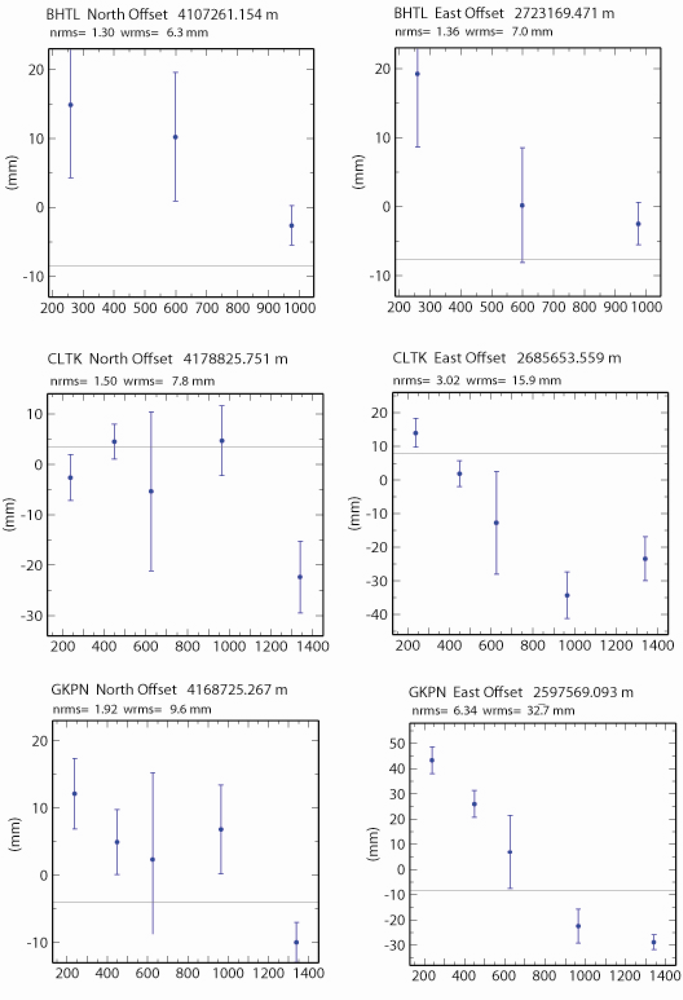


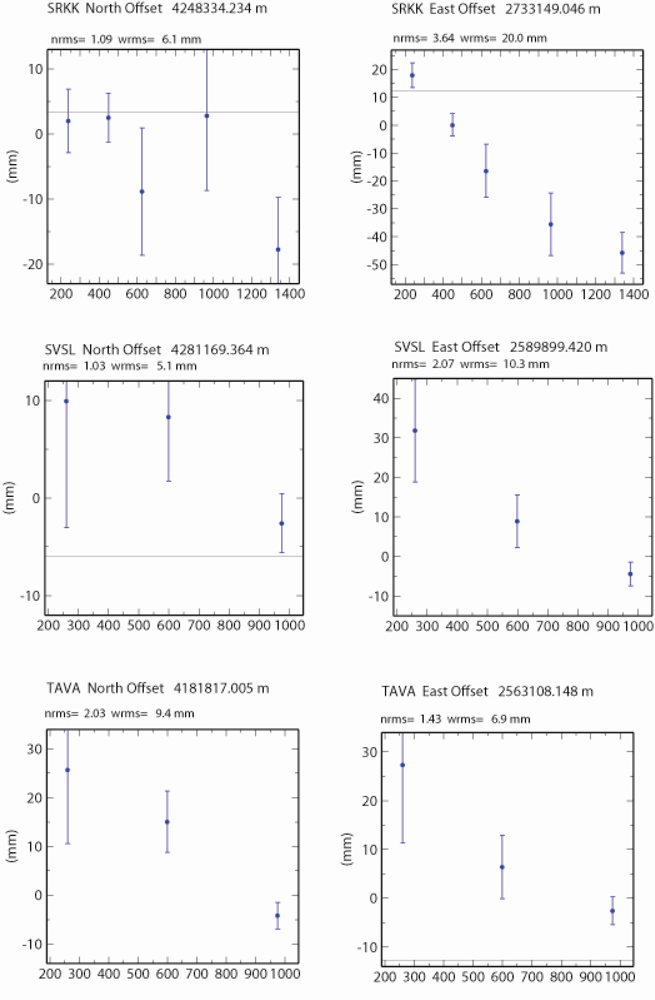
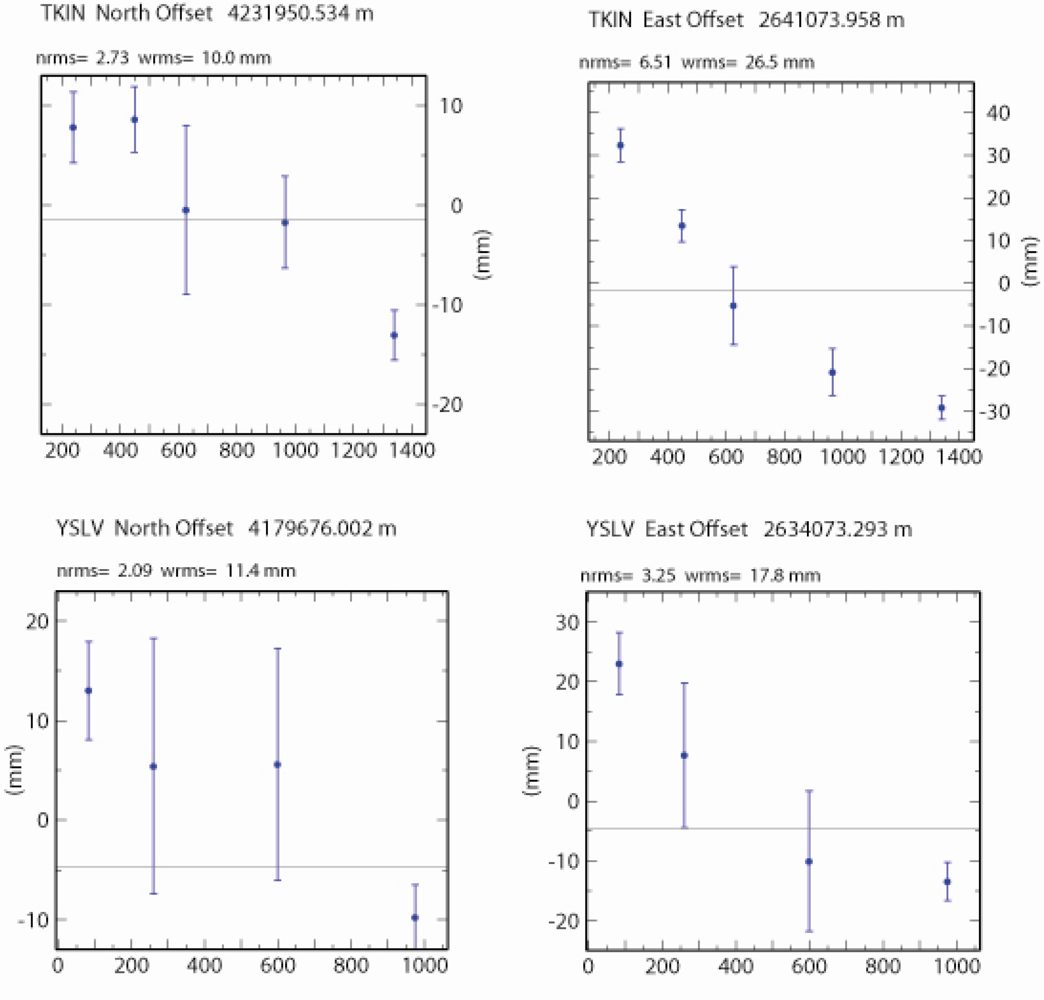
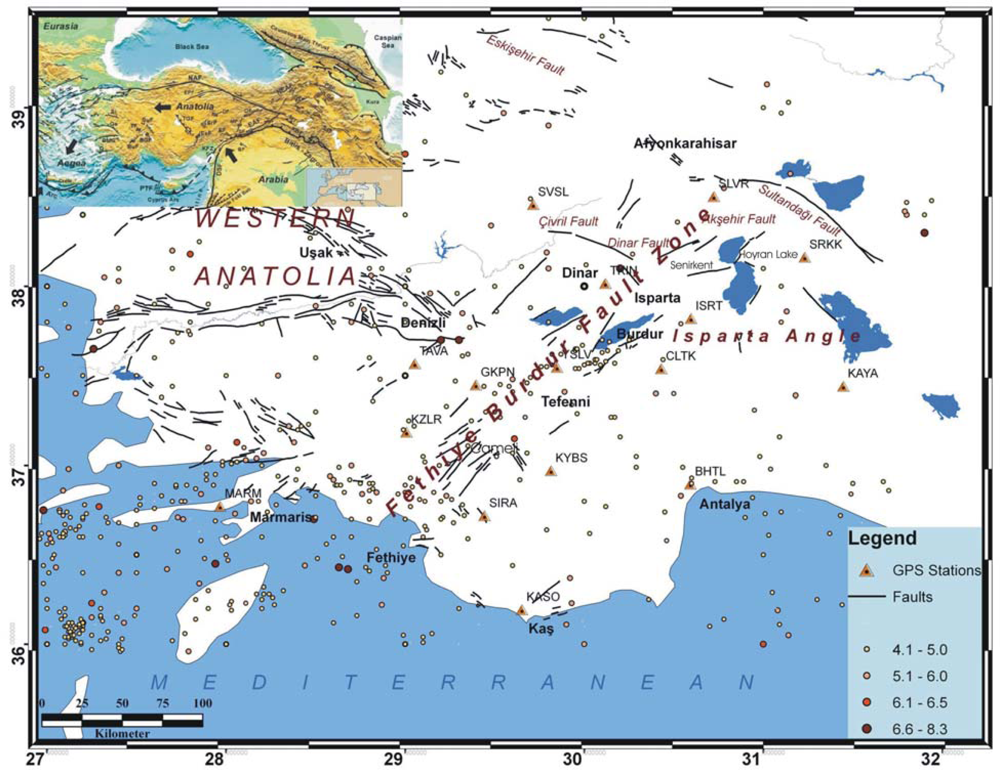

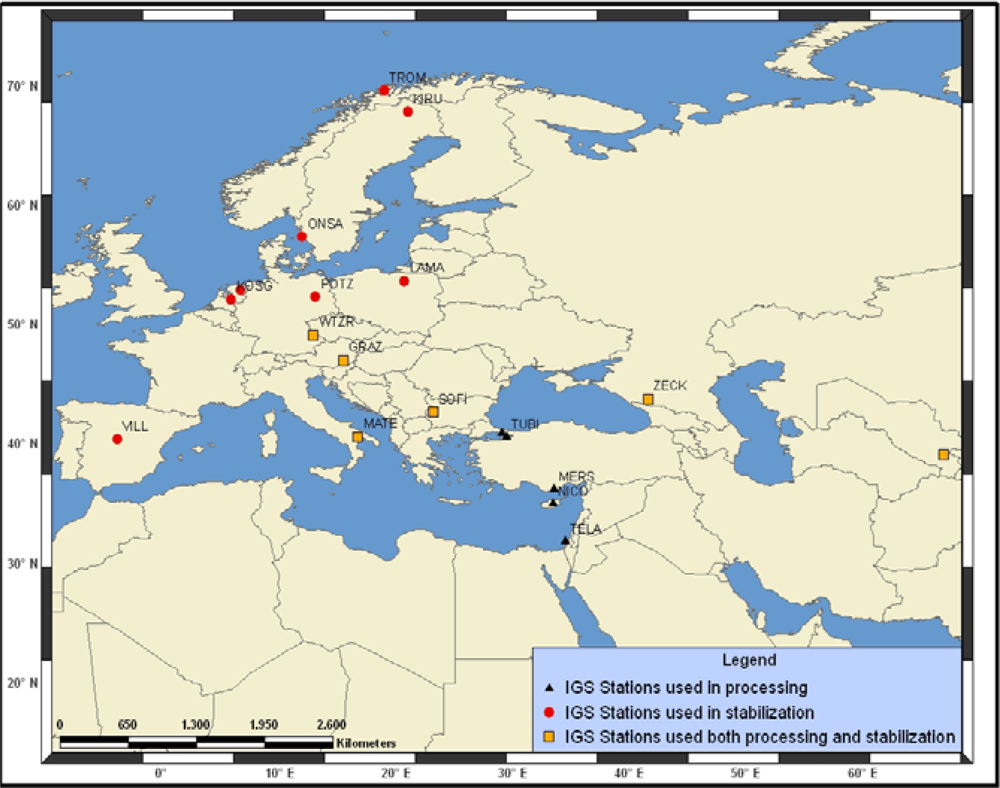
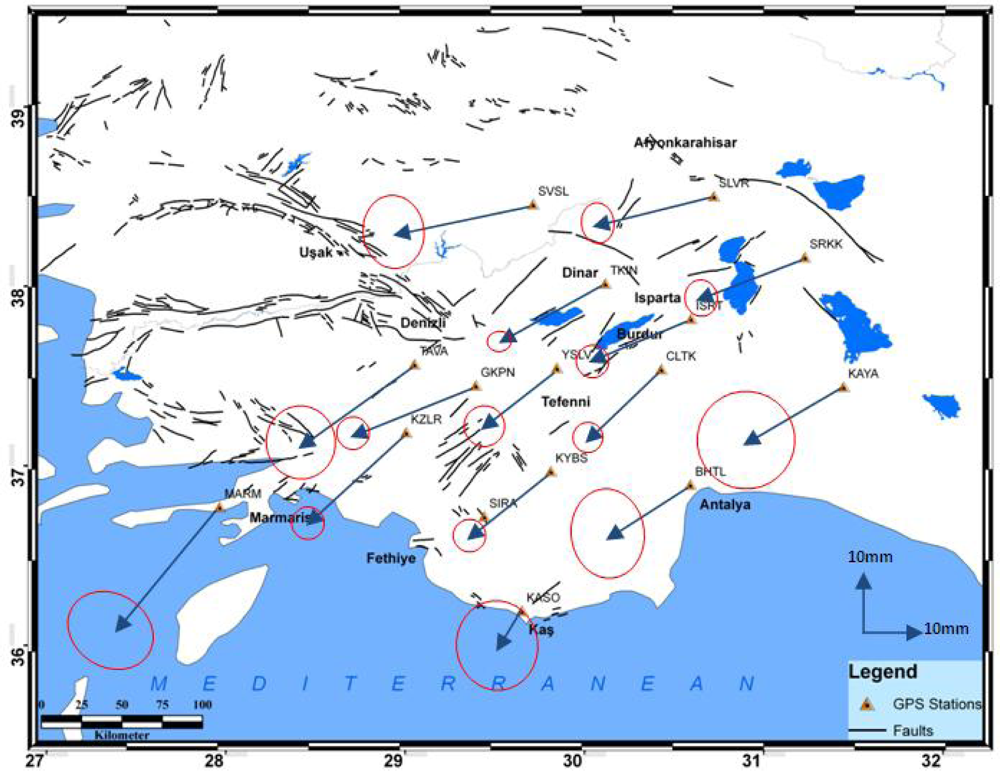


| Site | Lat (°) | Lon (°) | VE (mm) | VN (mm) | σVE (mm) | σVN (mm) |
|---|---|---|---|---|---|---|
| BHTL | 36.896 | 30.589 | −13.45 | −8.54 | 3.70 | 4.09 |
| CLTK | 37.53 | 30.427 | −12.06 | −11.45 | 1.47 | 1.55 |
| GKPN | 37.448 | 29.392 | −20.15 | −7.98 | 1.57 | 1.57 |
| ISRT | 37.82 | 30.592 | −16.06 | −6.92 | 1.51 | 1.61 |
| KASO | 36.194 | 29.648 | −4.14 | −5.95 | 3.97 | 4.24 |
| KAYA | 37.436 | 31.443 | −15.9 | −9.11 | 4.67 | 4.61 |
| KYBS | 36.971 | 29.81 | −13.22 | −11.14 | 1.52 | 1.47 |
| KZLR | 37.187 | 29.003 | −15.92 | −14.76 | 1.49 | 1.49 |
| MARM | 36.772 | 27.963 | −16.55 | −20 | 4.25 | 3.69 |
| SLVR | 38.503 | 30.72 | −19.38 | −4.82 | 1.69 | 1.90 |
| SRKK | 38.163 | 31.228 | −16.91 | −6.77 | 1.56 | 1.74 |
| SVSL | 38.458 | 29.711 | −22.40 | −4.67 | 3.10 | 3.36 |
| TAVA | 37.566 | 29.048 | −18.13 | −13.42 | 3.36 | 3.66 |
| TKIN | 38.016 | 30.114 | −16.79 | −8.93 | 1.13 | 1.01 |
| YSLV | 37.547 | 29.844 | −11.43 | −9.34 | 2.15 | 2.25 |
| Site | Lon (°) | Lat (°) | εmax (10−7 year−1) | σεmax (10−7 year−1) | εmin (10−7 year−1) | σεmin (10−7 year−1) |
|---|---|---|---|---|---|---|
| BHTL | 36.896 | 30.589 | 0.051 | 0.184 | −0.027 | 0.046 |
| CLTK | 37.530 | 30.427 | 0.691 | 0.048 | 0.015 | 0.279 |
| GKPN | 37.448 | 29.392 | 0.804 | 0.073 | 0.198 | 0.421 |
| ISRT | 37.820 | 30.592 | 0.507 | 0.061 | 0.022 | 0.193 |
| KASO | 36.194 | 29.648 | 0.368 | 0.297 | −0.601 | 0.870 |
| KAYA | 37.436 | 31.443 | 0.333 | 0.233 | −0.203 | 0.699 |
| KYBS | 36.971 | 29.810 | 0.496 | 0.072 | 0.130 | 0.200 |
| KZLR | 37.187 | 29.003 | 0.541 | 0.474 | 0.236 | 1.407 |
| MARM | 36.772 | 27.963 | 0.386 | 0.027 | 0.159 | 0.271 |
| SLVR | 38.503 | 30.720 | 0.585 | 0.030 | 0.003 | 0.093 |
| SRKK | 38.163 | 31.228 | 0.538 | 0.039 | −0.045 | 0.099 |
| SVSL | 38.458 | 29.711 | 0.868 | 0.026 | 0.087 | 0.155 |
| TAVA | 37.566 | 29.048 | 0.554 | 0.071 | 0.250 | 0.463 |
| TKIN | 38.016 | 30.114 | 0.428 | 0.039 | 0.023 | 0.203 |
| YSLV | 37.547 | 29.844 | 0.723 | 0.062 | 0.099 | 0.323 |
| IGS SITES | PROJECT SITES | |||||||
|---|---|---|---|---|---|---|---|---|
| NORTH | EAST | NORTH | EAST | |||||
| nrms | wrms | nrms | wrms | nrms | wrms | nrms | wrms | |
| 2003 | 0.4 | 0.3 | 0.6 | 0.6 | 1.9 | 2.7 | 2.0 | 3.2 |
| 2004 | 0.5 | 0.4 | 1.0 | 1.4 | 0.2 | 0.2 | 1.5 | 2.4 |
| 2004/2 | 3.9 | 3.7 | 3.0 | 3.9 | 2.7 | 6.1 | 2.4 | 6.1 |
| 2005 | 4.8 | 13.2 | 2.0 | 7.7 | 3.1 | 16.5 | 2.7 | 17.7 |
| 2006 | 1.3 | 1.5 | 1.3 | 1.8 | 1.8 | 3.6 | 2.0 | 5.9 |
© 2009 by the authors; licensee MDPI, Basel, Switzerland This article is an open-access article distributed under the terms and conditions of the Creative Commons Attribution license (http://creativecommons.org/licenses/by/3.0/).
Share and Cite
Erdoğan, S.; Şahin, M.; Tiryakioğlu, İ.; Gülal, E.; Telli, A.K. GPS Velocity and Strain Rate Fields in Southwest Anatolia from Repeated GPS Measurements. Sensors 2009, 9, 2017-2034. https://doi.org/10.3390/s90302017
Erdoğan S, Şahin M, Tiryakioğlu İ, Gülal E, Telli AK. GPS Velocity and Strain Rate Fields in Southwest Anatolia from Repeated GPS Measurements. Sensors. 2009; 9(3):2017-2034. https://doi.org/10.3390/s90302017
Chicago/Turabian StyleErdoğan, Saffet, Muhammed Şahin, İbrahim Tiryakioğlu, Engin Gülal, and Ali Kazım Telli. 2009. "GPS Velocity and Strain Rate Fields in Southwest Anatolia from Repeated GPS Measurements" Sensors 9, no. 3: 2017-2034. https://doi.org/10.3390/s90302017




